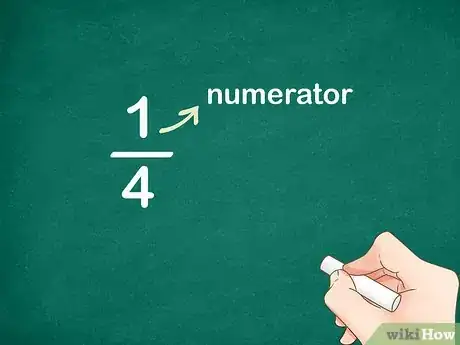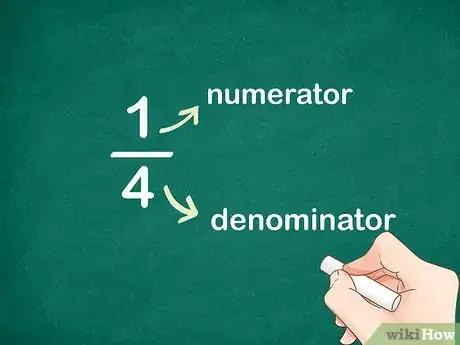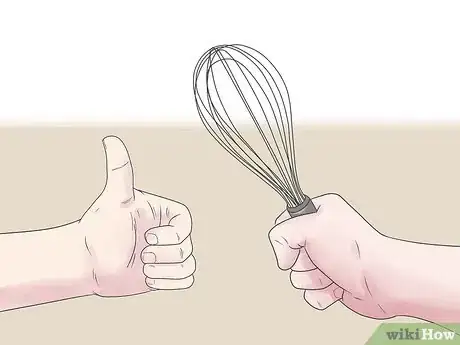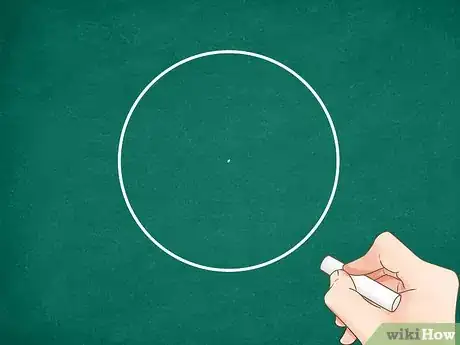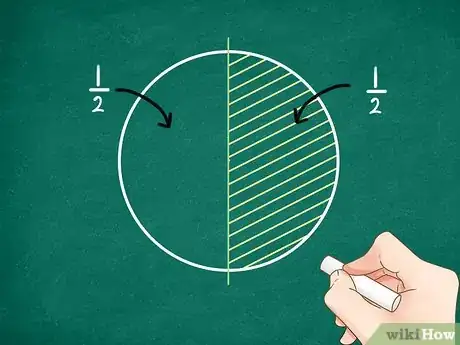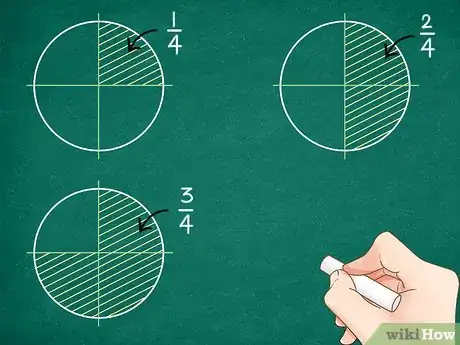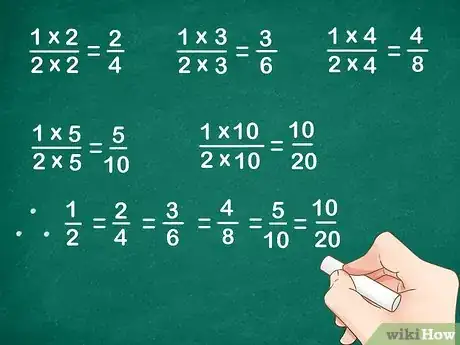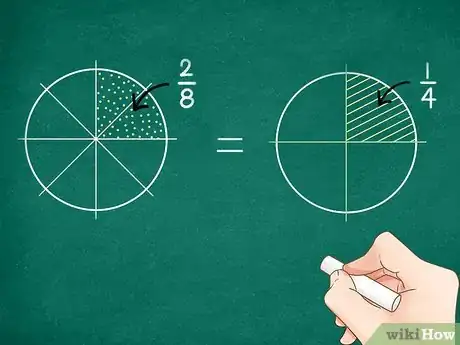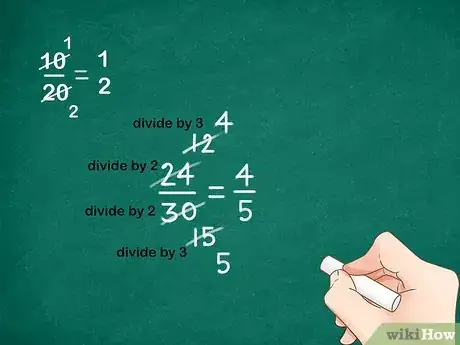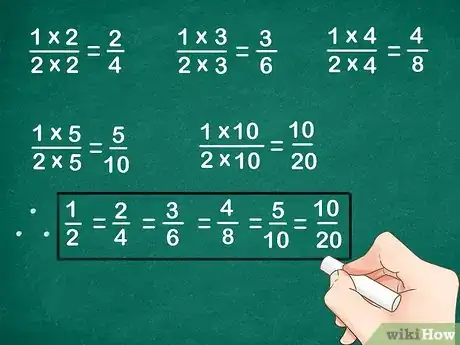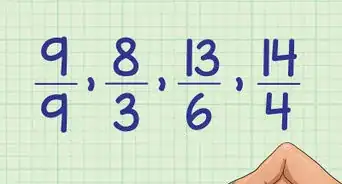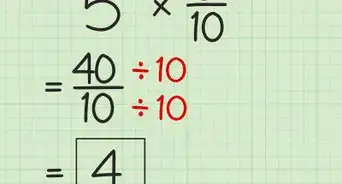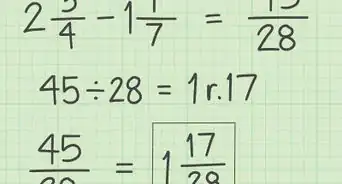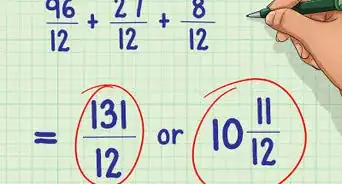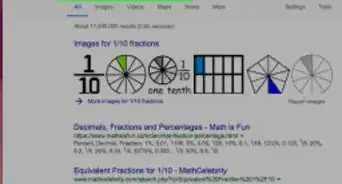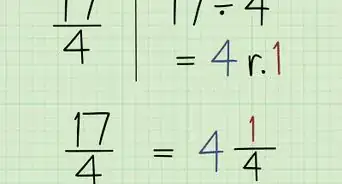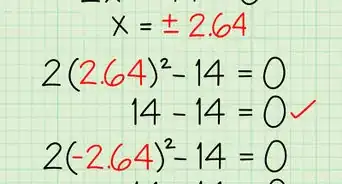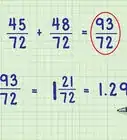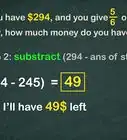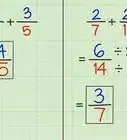This article was co-authored by Jake Adams. Jake Adams is an academic tutor and the owner of Simplifi EDU, a Santa Monica, California based online tutoring business offering learning resources and online tutors for academic subjects K-College, SAT & ACT prep, and college admissions applications. With over 14 years of professional tutoring experience, Jake is dedicated to providing his clients the very best online tutoring experience and access to a network of excellent undergraduate and graduate-level tutors from top colleges all over the nation. Jake holds a BS in International Business and Marketing from Pepperdine University.
There are 7 references cited in this article, which can be found at the bottom of the page.
wikiHow marks an article as reader-approved once it receives enough positive feedback. In this case, 100% of readers who voted found the article helpful, earning it our reader-approved status.
This article has been viewed 120,159 times.
A fraction is a way to describe a part of a whole.[1] If you have a whole pizza and your friend eats half of it, they will have eaten part of the whole pizza. You can divide the pizza into as many pieces as you like and each piece will represent one part of that whole pizza. Knowing how understand and use fractions is an important skill in mathematics and everyday life.
Steps
Defining a Fraction
-
1Identify the numerator. A fraction is always written with one number on top of a line and another number underneath that line. The numerator of a fraction is the top number. It is the “part” of the “whole” that you are talking about.[2]
- For example, in the fraction ¼, 1 is the numerator. The fraction indicates one part of a whole that has four parts.
-
2Identify the denominator. The denominator is the bottom number of the fraction and represents the “whole”. It is the number of parts the whole is divided into. To remember the denominator think “down”-ominator.[3]
- For example, in the fraction ¼, 4 is the denominator. This whole has been divided into four equal parts.
Advertisement -
3Recognize an improper fraction. A fraction is considered improper if the numerator (the top number) is larger than the denominator (the bottom number). When working with fractions, you never want to write a final solution as an improper fraction. Always remember to simplify it into a mixed or whole number.[4]
- Some examples of improper fractions: 10/3, 9/4, 15/3, 25/5.
-
4Simplify improper fractions into mixed or whole numbers. Some fractions can simply be divided into a whole number, while others will not divide evenly. Numbers that don't divide evenly must be rewritten as a mixed number.[5]
- To simplify an improper fraction, first divide the numerator by the denominator. For example, for the fraction 10/3, divide 10 by 3.
- 3 goes into 10 three times (3 x 3 = 9), but there will be a remainder of 1.
- Write the remainder as a fraction of the original denominator. With a remainder of 1 the fraction of the mixed number will be 1/3.
- The mixed number of 10/3 is 31/3.
- Note, not all improper fractions will be mixed numbers; some will simplify into whole numbers. For example: 25/5 simplifies to 5.
-
5Identify the use of fractions in your daily life. You might be surprised to find that you use fractions on a pretty regular basis throughout your day. You may know fractions by a different name, decimals. Do you ever trade or share food with your friends at lunch? Maybe you trade half of your chips for half a dessert. These are fractions!
- Do you ever help your parents with baking? Measuring cups use fractions. A recipe may call for ¼ teaspoon of vanilla or 2/3 of a cup of flour.
- Pay attention throughout your day and see how many times you use fractions without even realizing it.
Using Pictures to Represent Fractions
-
1Draw a circle. A good way to visualize fractions is to draw a picture to represent the fraction you are working with. You can start with any shape you would like, but here we will use a circle; think of it like a pie. Draw a large circle that you will be able to divide into multiple equal parts.[6]
- The circle itself is not a fraction. It represents the whole number one.
-
2Cut that circle in half. Draw a straight line down the middle of the circle dividing it into two equal pieces. You now have a circle that has two parts that make it a whole. When you are dividing shapes to represent fractions, remember to always divide the shape up evenly so you have equal parts.[7]
- If you shade one part of the circle, you will have shaded ½ of the circle. The other half remains untouched.
-
3Cut the circle into four equal pieces. Now, draw another straight line horizontally across the center of the circle. The circle should now be divided into four equal parts. You can represent this whole circle as 4/4.[8]
- If you shade one piece of the circle, you would have ¼ of the circle shaded.
- If you shade two pieces of the circle, you would have 2/4 of the circle shaded. Note that 2/4 simplifies to ½. You can also see this visually because you have shaded half of the circle even though it is divided into 4 parts.
-
4Cut the circle into eight equal pieces. You can continue to divide the circle into as many equal parts as you would like. Adding two more lines through the quarters will give you a circle divided into eight equal parts.[9]
- Continue shading parts and writing the fraction that represents the shaded area. Remember, for a circle divided into eight parts, the denominator will always be 8; only the numerator will change to represent the shaded regions.
Recognizing Equivalent Fractions
-
1Define equivalent fractions. An equivalent fraction is a set of fractions that may look different from each other, but in reality are the same when reduced to their simplest forms.[10] The easiest way to recognize equivalent fractions is to simplify each fraction and compare them.[11]
- An example of three equivalent fractions: 1/2, 5/10, 10/20
-
2Draw diagrams of each fraction. When you are first starting out with fractions, an easy way to understand them is to draw a picture. Remember, the “whole” of the fraction is represented by the denominator and is the bottom number of the fraction.[12]
- Compare the diagrams of each fraction and see if they match. A diagram of 1/2, 5/10, and 10/20 will have identical shaded regions and therefore are all equivalent fractions.
- Note: For numbers with large denominators, it will be a bit more difficult to draw pictures.
-
3Simplify all of the fractions. Another way to check for equivalent fractions is to reduce each fraction to its simplest form. You will frequently come across fractions that haven't been simplified and they may look different in this form. Reduce both of the fractions and then compare them.
- For example: 1/2 is in its simplest form, but 5/10 and 10/20 can be simplified further.
- 5/10 can be divided by 5 to simplify to 1/2.
- 10/20 can be divided by 10 to simplify to 1/2.
-
4Cross multiply the two fractions. To cross multiply means to set the two fractions equal to each other and multiply across the equals sign in a “cross” or “x” shape. The denominator of one fraction is multiplied by the numerator of the other fraction. Then the other denominator and numerator are multiplied together.[13] If the two products are equal to each other, the fractions are equivalent fractions.
- For example: set 10/20 = 1/2.
- Cross multiply: 2 x 10 = 20 x 1.
- 20 = 20; therefore, the fractions are equivalent.
- Another example: 5/10 = 1/2.
- Cross multiply: 5 x 2 = 10 x 1.
- 10 = 10; therefore, the fractions are equivalent.
Community Q&A
-
QuestionWhat fraction is greater than 1?
 DonaganTop AnswererAny fraction is greater than 1 if its numerator is greater than its denominator.
DonaganTop AnswererAny fraction is greater than 1 if its numerator is greater than its denominator. -
QuestionHow many tenths are there in two and half?
 DonaganTop AnswererThere are 10 tenths in 1, 20 tenths in 2, and 5 tenths in one-half. So 2½ has 20 + 5 = 25 tenths.
DonaganTop AnswererThere are 10 tenths in 1, 20 tenths in 2, and 5 tenths in one-half. So 2½ has 20 + 5 = 25 tenths. -
QuestionI still don't understand how to simplify. How do I know what numbers to divide or multiply it by to equal the fraction/number you want it to be?
 DonaganTop AnswererSimplifying a fraction means converting both the numerator and the denominator to smaller numbers while leaving the value of the fraction unchanged. The way to do this is to divide both numerator and denominator by the same small number (such as 2, 3, or 5) and perhaps doing it again and again until you can't reduce any further (remembering that you always want both the numerator and denominator to be whole numbers).
DonaganTop AnswererSimplifying a fraction means converting both the numerator and the denominator to smaller numbers while leaving the value of the fraction unchanged. The way to do this is to divide both numerator and denominator by the same small number (such as 2, 3, or 5) and perhaps doing it again and again until you can't reduce any further (remembering that you always want both the numerator and denominator to be whole numbers).
References
- ↑ https://www.mathsisfun.com/fractions.html
- ↑ https://www.mathsisfun.com/fractions.html
- ↑ https://www.mathsisfun.com/fractions.html
- ↑ https://www.khanacademy.org/math/cc-fourth-grade-math/imp-fractions-2/imp-mixed-numbers/a/mixed-numbers-and-improper-fractions-review
- ↑ https://www.mathsisfun.com/improper-fractions.html
- ↑ http://www.homeschoolmath.net/teaching/f/understanding_fractions.php
- ↑ http://www.homeschoolmath.net/teaching/f/understanding_fractions.php
- ↑ http://www.homeschoolmath.net/teaching/f/understanding_fractions.php
- ↑ http://www.homeschoolmath.net/teaching/f/understanding_fractions.php
About This Article
To understand fractions, start by identifying the numerator and denominator of a fraction. The numerator is the number written above the line. It is the “part” of the “whole” that you're talking about. The denominator is the bottom number of the fraction and represents the “whole." For example, in the fraction 1/4, 1 is the numerator and 4 is the denominator. This means that the whole has been divided into 4 equal parts! For tips on recognizing and simplifying improper fractions, read on!
